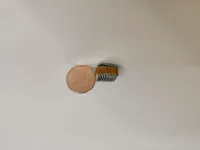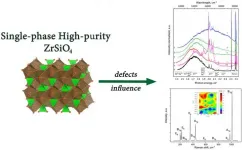Sensor and detoxifier in one
Crystalline polymers for the rapid detection and efficient degradation of ozone
2021-02-05
(Press-News.org) Ozone is a problematic air pollutant that causes serious health problems. A newly developed material not only quickly and selectively indicates the presence of ozone, but also simultaneously renders the gas harmless. As reported by Chinese researchers in Angewandte Chemie, the porous "2-in-one systems" also function reliably in very humid air.
Ozone (O(3)) can cause health problems, such as difficulty breathing, lung damage, and asthma attacks. Relevant occupational safety regulations therefore limit the concentrations of ozone allowable in the workplace. Previous methods for the detection of ozone, such as those based on semiconductors, have a variety of disadvantages, including high power consumption, low selectivity, and malfunction due to humid air. Techniques aimed at reducing the concentration of ozone have thus far been based mainly on activated charcoal, chemical absorption, or catalytic degradation.
A team led by Zhenjie Zhang at Nankai University (Tianjin, China) set themselves the goal of developing a material that can both rapidly detect and efficiently remove ozone. Their approach uses materials known as covalent organic frameworks (COFs). COFs are two- or three-dimensional organic solids with extended porous crystalline structures; their components are bound together by strong covalent bonds. COFs can be tailored to many applications through the selection of different components.
The researchers selected easily producible, highly crystalline COFs made of aromatic ring systems. The individual building blocks are bound through connective groups called imines (a nitrogen atom bound to a carbon atom by a double bond). These are at the center of the action.
The imine COFs indicate the presence of ozone through a rapid color change from yellow to orange-red, which can be seen with the naked eye and registered by a spectrometer. Unlike many other detectors, the imine COF also works very reliably, sensitively, and efficiently at high humidity and over a wide temperature range. In the presence of water, the water molecules will preferentially bind to the imine groups. Consequently, the researchers assert, a hydroxide ion (OH(?)) is released, which reacts with an ozone molecule. The positively charged hydrogen atom remains bound to the imine group, causing the color change. If more ozone than water is present (or the ozone-laden air is fully dry), the excess ozone binds to the imine groups and splits them. Each imine group degrades two molecules of ozone. This also causes a color change and the crystalline structure slowly begins to collapse. The imine COF thus doesn't just detect the ozone, but also reliably and efficiently breaks the harmful gas down. This makes it more effective than many of the traditional materials employed for this purpose.
INFORMATION:
About the Author
Dr. Zhenjie Zhang is a full Professor of inorganic chemistry at Nankai University. He is currently focusing on developing new crystalline porous materials (e.g., MOFs, COFs, and cages) for value-added product separation and purification, as well as creating smart materials for sensors, actuators, or robots. He is a recipient of the ACS-DIC Young Investigator Award and the CCS JINGQING Chemistry Investigator Award.
mailto:zhangzhenjie@nankai.edu.cn
ELSE PRESS RELEASES FROM THIS DATE:
2021-02-05
Thermoelectric generators, TEGs for short, convert ambient heat into electrical power. They enable maintenance-free, environmentally friendly, and autonomous power supply of the continuously growing number of sensors and devices for the Internet of Things (IoT) and recovery of waste heat. Scientists of Karlsruhe Institute of Technology (KIT) have now developed three-dimensional component architectures based on novel, printable thermoelectric materials. This might be a milestone on the way towards use of inexpensive TEGs. The results are reported in npj Flexible Electronics (DOI: 10.1038/s41528-020-00098-1) and ACS Energy Letters (DOI: 10.1021/acsenergylett.0c02159).
"Thermoelectric generators directly convert thermal into electrical energy. This technology enables ...
2021-02-05
The scientific novelty of the work of scientists from Ural Federal University, Institute of Solid State Chemistry and Geology and Geochemistry of the Ural Branch of the Russian Academy of Sciences lies in the fact that for the first time scientists solved the task of creating zircon with certain spectral properties. To this end, they have worked out the so-called sol-gel method.
It is distinguished by its technological simplicity, controllability of processes and allows synthesizing a larger volume of products with high purity than with other ...
2021-02-05
Using patient data, artificial intelligence can make a 90 percent accurate assessment of whether a person will die from COVID-19 or not, according to new research at the University of Copenhagen. Body mass index (BMI), gender and high blood pressure are among the most heavily weighted factors. The research can be used to predict the number of patients in hospitals, who will need a respirator and determine who ought to be first in line for a vaccination.
Artificial intelligence is able to predict who is most likely to die from the coronavirus. In doing so, it can also help decide who should be at the front of the line for the precious vaccines now being administered across Denmark.
The result is from a newly published study by researchers at the University of Copenhagen's Department ...
2021-02-05
- World's wildlife, from giraffes to voles, kangaroos to coyotes being hit by aircraft.
- Study identifies incidences at airports in 47 countries across the globe.
- 'Runway Roadkill' increasing by up to 68% annually and has caused damage that has cost in excess of $103 million in the United States alone over a 30 year period.
- It is hoped study could pave way for international efforts to protect wildlife and reduce costly aircraft damage.
From giraffes to the world's smallest mammals, the world's wildlife is being increasingly struck by aircraft, a global study finds.
Airports from Sydney to London and the USA to Germany were examined by researchers who ...
2021-02-05
LEBANON, NH - Dartmouth's and Dartmouth-Hitchcock's Norris Cotton Cancer Center (NCCC) is the first cancer center in the world to install BeamSite Cherenkov imaging cameras in its radiotherapy treatment rooms. The camera system, invented, validated and commercialized by entrepreneurs from NCCC and Dartmouth spinoff biomed tech company, DoseOptics, LLC, captures imaging and real-time video of the beam directly on the patient, allowing the radiation oncology team to visualize treatment delivery.
Cherenkov imaging makes radiation treatment a visual process. The Cherenkov effect occurs when photon or electron radiation beams interact with tissue, such as skin, producing a small light ...
2021-02-05
University of Texas at Arlington researchers have developed a technique that programs 2D materials to transform into complex 3D shapes.
The goal of the work is to create synthetic materials that can mimic how living organisms expand and contract soft tissues and thus achieve complex 3D movements and functions. Programming thin sheets, or 2D materials, to morph into 3D shapes can enable new technologies for soft robotics, deployable systems, and biomimetic manufacturing, which produces synthetic products that mimic biological processes.
Kyungsuk Yum, an associate professor in the Materials ...
2021-02-05
URBANA, Ill. ¬- Mealtimes are a central aspect of family life, affecting the health and wellbeing of both children and adults. Although the benefits of healthy mealtimes are straightforward, helping all families realize those benefits is quite complicated, new research from University of Illinois shows.
The study highlights ways in which some solutions - such as an exclusive focus on improving food access or on improving mealtime preparation and organization skills - may be less effective if done in isolation, says Allen Barton, assistant professor in the Department of Human Development and Family Studies at ...
2021-02-05
Researchers from Kumamoto University (Japan) have clarified the mechanism by which blood and lymph vessels remain segregated from one another after development. The characteristics and structures of these two vessel types are very similar, and how they maintain separation has remained unexplained for many years. In this study, researchers found that the molecule Folliculin (FLCN) in vascular endothelial cells acts as a gatekeeper to maintain that separation.
Blood and lymphatic vessels form independent networks until the final confluence at the left and right venous angles in the neck. Blood vessels act as a pipeline that ...
2021-02-05
We've all felt stressed at some point, whether in our personal or professional lives or in response to exceptional circumstances like the COVID-19 pandemic. But until now there has been no way to quantify stress levels in an objective manner.
That could soon change thanks to a small wearable sensor developed by engineers at EPFL's Nanoelectronic Devices Laboratory (Nanolab) and Xsensio. The device can be placed directly on a patient's skin and can continually measure the concentration of cortisol, the main stress biomarker, in the patient's sweat.
Cortisol: A double-edged sword
Cortisol is a steroid hormone ...
2021-02-05
The group led by Dr. Enrique J. Calderón - "Clinical Epidemiology and Vascular Risk" at the Institute of Biomedicine of Seville - IBiS/University Hospitals Virgen del Rocío and Macarena/CSIC/University of Seville, also a member of CIBERESP, participated in a project with researchers from CIBER-BBN, in which they developed systems to detect Pneumocystis jirovecii, an atypical fungus responsible for very severe pneumonia in immunosuppressed patients. The results have been published in the journals Nanomaterials and Journal of Fungi, and are the fruit of collaboration with the CIBER-BBN groups led by Dr. Laura Lechuga, ...
LAST 30 PRESS RELEASES:
[Press-News.org] Sensor and detoxifier in one
Crystalline polymers for the rapid detection and efficient degradation of ozone





